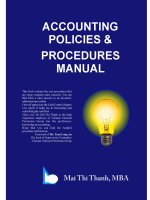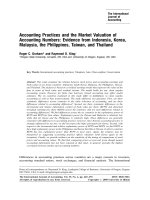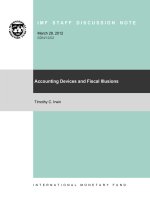Accounting concepts and principles
Bạn đang xem bản rút gọn của tài liệu. Xem và tải ngay bản đầy đủ của tài liệu tại đây (187.97 KB, 50 trang )
Accounting Concepts
and Principles
1
Introduction
• Actually there are a number of accounting
concepts and principles based on which we
prepare our accounts
• These generally accepted accounting
principles lay down accepted assumptions
and guidelines and are commonly referred
to as accounting concepts
2
Users of Financial Statements
• Investors
– Need information about the profitability, dividend yield
and price earnings ratio in order to assess the quality
and the price of shares of a company
• Lenders
– Need information about the profitability and solvency of
the business in order to determine the risk and interest
rate of loans
• Management
– Need information for planning, policy making and
evaluation
• Suppliers and trade creditors
– Need information about the liquidity of business in order
to access the ability to repay the amounts owed to them
3
• Government
– Need information about various businesses for statistics
and formulation of economic plan
• Customers
– Interested in long-tem stability of the business and
continuance of the supply of particular products
• Employees
– Interested in the stability of the business to provide
employment, fringe benefits and promotion opportunities
• Public
– Need information about the trends and recent
development
4
Limitations of conventional
financial statements
• Companies may use different
methods of valuation, cost calculation
and recognizing profit
• The balance sheet does not reflect
the true worth of the company
• Financial statements can only show
partial information about the
financial position of an enterprise,
instead of the whole picture
5
Accounting Concepts
6
Accounting Concepts
• Business entity
• Money Measurement/stable
monetary unit
• Going Concern
• Historical Cost
• Prudence/conservatism
• Materiality
7
•
•
•
•
•
•
•
Objectivity
Consistency
Accruals/matching
Realization
Uniformity
Disclosure
Relevance
8
Business Entity
• Meaning
– The business and its owner(s) are two
separate existence entity
– Any private and personal incomes and
expenses of the owner(s) should not be
treated as the incomes and expenses of
the business
9
Business Entity
10
• Examples
– Insurance premiums for the owner’s
house should be excluded from the
expense of the business
– The owner’s property should not be
included in the premises account of the
business
– Any payments for the owner’s personal
expenses by the business will be treated
as drawings and reduced the owner’s
capital contribution in the business
11
Money Measurement
12
Money Measurement
• Meaning
– All transactions of the business are
recorded in terms of money
– It provides a common unit of
measurement
• Examples
– Market conditions, technological changes
and the efficiency of management would
not be disclosed in the accounts
13
Going Concern
14
Going Concern
• Meaning
– The business will continue in operational
existence for the foreseeable future
– Financial statements should be prepared
on a going concern basis unless
management either intends to liquidate
the enterprise or to cease trading, or
has no realistic alternative but to do so
15
• Example
– Possible losses form the closure of
business will not be anticipated in the
accounts
– Prepayments, depreciation provisions
may be carried forward in the
expectation of proper matching against
the revenues of future periods
– Fixed assets are recorded at historical
cost
16
Historical Cost
17
Historical Cost
• Meaning
– Assets should be shown on the balance
sheet at the cost of purchase instead of
current value
• Example
– The cost of fixed assets is recorded at
the date of acquisition cost. The
acquisition cost includes all expenditure
made to prepare the asset for its
intended use. It included the invoice
price of the assets, freight charges,
insurance or installation costs 18
Prudence/Conservatism
19
Prudence/Conservatism
• Meaning
– Revenues and profits are not
anticipated. Only realized profits with
reasonable certainty are recognized in
the profit and loss account
– However, provision is made for all known
expenses and losses whether the amount
is known for certain or just an
estimation
– This treatment minimizes the reported
profits and the valuation of assets
20
• Example
– Stock valuation sticks to rule of the
lower of cost and net realizable value
– The provision for doubtful debts should
be made
– Fixed assets must be depreciated over
their useful economic lives
21
Materiality
22
Materiality
• Meaning
– Immaterial amounts may be aggregated
with the amounts of a similar nature or
function and need not be presented
separately
– Materiality depends on the size and
nature of the item
23
• Example
– Small payments such as postage,
stationery and cleaning expenses should
not be disclosed separately. They should
be grouped together as sundry expenses
– The cost of small-valued assets such as
pencil sharpeners and paper clips should
be written off to the profit and loss
account as revenue expenditures,
although they can last for more than one
accounting period
24
Objectivity
25









